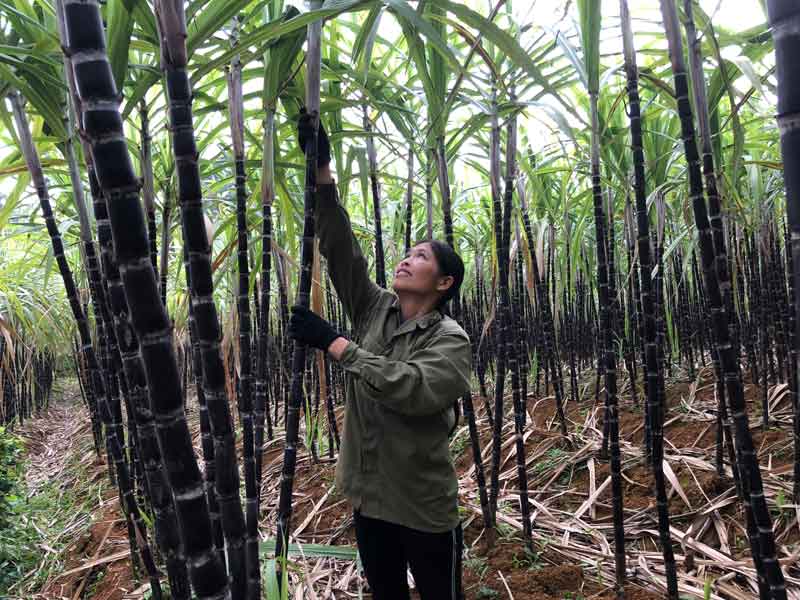
(HBO) – Farmers in Cao Phong district are delighted at welcoming sweet sugarcane season in the beginning of the Lunar New Year (Tet) 2019. Lines of trucks carry buckets of sugarcane for sale across the country.
Family of Bui Van Chuong in Trang Giua hamlet, Tan Phong
commune has more than 3,000ha of purple sugarcane with an average yield of over
10,000 trees. Chuong said sugarcanes were sold slowly, at the highest price of only
3,000VND per tree in the same period last year. During this crop, all gardens have
been ordered at a wholesale price of 4,500VND per tree. With 3,000 sq.m of
purple sugarcane, his family earned nearly 50 million VND. Improving sugarcane
value and favourable weather conditions have made his family happier to welcome
Tet.

Photo: Purple sugarcane growing households in Trang Giua hamlet, Tan
Phong commune, Cao Phong district are delighted at high sugarcane prices.
Nam Phong commune is not only one of the district’s key sugarcane
growing areas but also built and spread a growing model by tissue culture. According
to statistics, the locality grew 170ha of sugarcane in this crop while over 70
percent of households in the commune earned their main income from sugarcane
farming, including purple sugarcane and sugarcane juice. Vice Chairman of the
communal People’s Committee Dinh Duc Lam said purple sugarcanes waiting for
harvest are plentiful while over 5ha of others grown by tissue culture were
sold all. In particular, sugarcanes with tissue culture are sold at 7,000 VND
per tree, 1.5-fold higher than conventional ones. Since the launch of the tissue
culture model in 2015, over 20 households have joined and bought seeds for
cultivation. At present, many households earn hundreds of millions of VND per
crop on a site of 5,000 – 7,000 sq.m.
In 2018, the district was home to nearly 2,700ha of
sugarcanes, including 1,010ha of purple sugarcane and over 1,600ha of white
sugarcane for juice. Purple sugarcanes grown by tissue culture were spread in
the communes of Tay Phong, Nam Phong, Tan Phong, Thu Phong, Dong Phong and Xuan
Phong with nearly 20ha. Farmers have so far harvested about 500ha of purple
sugarcane, or nearly half of the total area. The current price is 4,000 – 6,000
VND per tree, bringing the total value to 160 – 240 million VND per ha./.
According to data from the Hoa Binh Provincial Party Committee, the industrial production index for the first six months of 2025 is estimated to have increased by 20% compared to the same period last year. This marks the highest year-on-year growth rate for this period since 2020.
In the first six months of 2025, Hoa Binh province’s export turnover was estimated at 1.145 billion USD, marking an 18.11% increase compared to the same period in 2024. Import turnover was estimated at $ 804 million, a 17.15% increase, which helped the province maintain a positive trade balance.
The lives of the ethnic minority farmers in Tan Lac district have gradually improved thanks to the new directions in agricultural production. This is a testament to the collective strength fostered through the professional associations and groups implemented by various levels of the district’s Farmers’ Union.
With the motto the "product quality comes first,” after nearly one year of establishment and operation, Muong village’s Clean Food Agricultural and Commercial Cooperative, located in Cau Hamlet, Hung Son Commune (Kim Boi district), has launched reputable, high-quality agricultural products to the market that are well-received by consumers. The products such as Muong village’s pork sausage, salt-cured chicken, and salt-cured pork hocks have gradually carved out a place in the market and they are on the path to obtaining the OCOP certification.
In the past, the phrase "bumper harvest, rock-bottom prices" was a familiar refrain for Vietnamese farmers engaged in fragmented, small-scale agriculture. But today, a new spirit is emerging across rural areas of Hoa Binh province - one of collaboration, organisation, and collective economic models that provide a stable foundation for production.
Maintaining growing area codes and packing facility codes in accordance with regulations is a mandatory requirement for agricultural products to be eligible for export. Recently, the Department of Agriculture and Environment of Hoa Binh province has intensified technical supervision of designated farming areas and packing facilities to safeguard the "green passport" that enables its products to access international markets.



